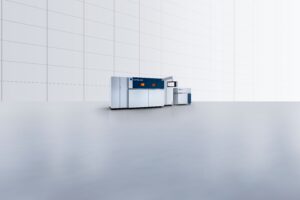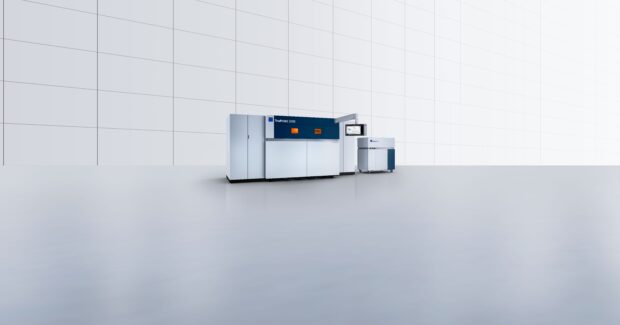Adding and Subtracting: Exploring the Preform Process and Hybrid Metal 3D Printing
By embracing hybrid approaches to 3D metal printing, manufacturers can achieve greater efficiency, reduce waste, and create parts that were previously impossible to produce.
Posted: September 30, 2024

3D printing, also known as additive manufacturing (AM), has long been promoted as a revolutionary technology poised to reshape the future of manufacturing. However, the reality of AM is more nuanced than the hype might suggest. While 3D printing offers unique advantages, it is unlikely to replace traditional manufacturing entirely. Instead, a growing trend towards hybrid manufacturing, where traditional and additive techniques complement each other, is emerging as the most effective path forward. At the heart of this hybrid approach lies a process known as “preform,” a technique that combines the strengths of traditional and additive manufacturing to produce parts more efficiently and cost-effectively.
The Limitations of 3D Printing in Isolation
Despite the enthusiasm surrounding 3D printing, there are inherent limitations to the technology that prevent it from being a complete replacement for traditional manufacturing methods. One of the primary challenges is the speed of the process. Current 3D printing technology, particularly when working with metals, involves a relatively slow process of laying down powdered material and melting it layer by layer to create a solid part. This process, while capable of producing highly complex geometries that would be impossible to create with traditional methods, is not well-suited for high-volume production.
Furthermore, many parts produced via 3D printing sometimes require significant post-processing, such as machining, to achieve the desired surface finish or to meet tight tolerances. In the case of metal 3D printing, for example, the printed part is often removed from the build plate and then subjected to various machining operations. This reality underscores the fact that 3D printing is not a standalone solution but rather one that works best in conjunction with other manufacturing techniques.
Introducing the Preform Process: A Hybrid Approach
Recognizing the limitations of traditional 3D printing, companies like TRUMPF have developed innovative approaches to hybrid manufacturing. One such approach is the preform process, which reverses the typical order of operations by machining the part first and then adding the 3D printed features. This technique not only streamlines the manufacturing process but also opens up new possibilities for creating complex, high-performance parts.
The preform process begins with an “off-the-shelf” part, known as the preform base, which is manufactured using traditional methods. This base acts as a foundation upon which the 3D printed portion of the part is built. By starting with a pre-machined base, manufacturers can focus the additive process only on the areas of the part that truly benefit from 3D printing, such as intricate internal cooling channels or other complex geometries. This approach significantly reduces the amount of material that needs to be printed, which in turn decreases build time and overall cost.
The Advantages of the Preform Process
The preform process offers several key advantages over traditional 3D printing and even over purely traditional manufacturing methods. First and foremost, it allows manufacturers to produce hybrid parts that leverage the best of both worlds. By combining a traditionally manufactured base with a 3D printed upper section, manufacturers can take advantage of the design freedom offered by additive manufacturing while maintaining the cost-effectiveness and speed of traditional methods.
Another significant advantage of the preform process is its ability to reduce waste. In a typical 3D printing scenario, the entire part must be printed to incorporate any advanced features, such as internal cooling channels. This means that large portions of the part, which could have been produced more efficiently using traditional methods, are still subject to the slower, more expensive additive process. With preform, only the portions of the part that require 3D printing are actually printed, reducing the amount of wasted material and time.
Additionally, the preform process enhances repeatability and scalability. At TRUMPF, for example, the process is supported by advanced software and a high-resolution camera system that aligns the digital design with the physical preform base. This automated alignment ensures that each part is produced consistently, making it easier to scale up production for larger quantities.
Real-world Applications
The benefits of the preform process are not just theoretical. Manufacturers have already seen significant improvements in their manufacturing processes by implementing this hybrid approach. For example, one electronics company used the preform process with their TRUMPF TruPrint 5000 to create an injection mold tool. The resulting hybrid mold insert combined the benefits of precision of traditional machining with the geometric freedom of metal 3D printing, leading to a tool with integrated internal cooling channels.
These cooling channels, which would have been impossible to produce using traditional methods alone, allowed the manufacturer to reduce their scrap rate and save costs by improving the consistency of their injection molding process. Moreover, the enhanced cooling capabilities helped to reduce cycle times, further increasing efficiency and productivity. This case study illustrates how the preform process can be used to solve real-world manufacturing challenges and deliver tangible benefits.
The Future of Hybrid Manufacturing: Embracing Innovation
As the manufacturing industry continues to evolve, it is becoming increasingly clear that the future lies not in a wholesale replacement of traditional methods but in the intelligent integration of new and existing technologies. The preform process exemplifies this trend, offering a way to combine the strengths of traditional machining with the advantages of 3D printing.
The success of this approach depends not just on the technology itself but on the creativity and ingenuity of the people who use it. The preform process is more than just a technical solution; it is an enabling technology that empowers manufacturers to innovate and push the boundaries of what is possible.
We encourage manufacturers to explore the potential of hybrid manufacturing and to think critically about how they can apply the preform process in their own operations. Whether it is used to reduce costs, improve part performance, or simply streamline production, the preform process can create a wide range of opportunities for manufacturers. TRUMPF experts can collaborate with customers to develop custom solutions that meet their specific needs and unlock new possibilities.
A Challenge to the Industry
While 3D printing is unlikely to replace traditional manufacturing outright, the combination of additive and traditional methods through the preform process offers a compelling vision for the future of manufacturing. By embracing hybrid approaches, manufacturers can achieve greater efficiency, reduce waste, and create parts that were previously impossible to produce. The challenge now is for the industry to recognize these opportunities and to take full advantage of the tools and technologies available.
TRUMPF expertise and technology can make such hybrid manufacturing a reality. The preform process is just the beginning. The real innovation lies in how manufacturers will use it to shape the future of the industry.

















